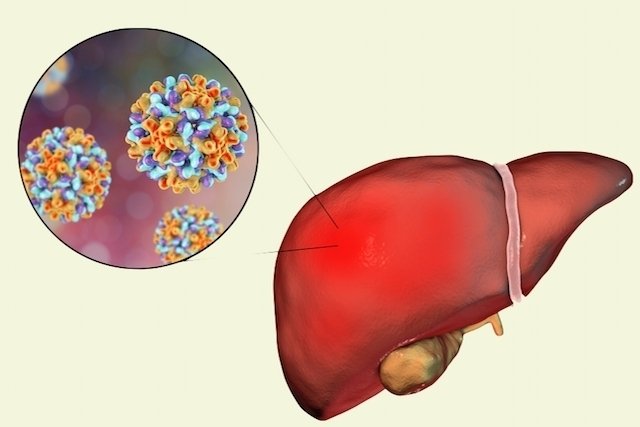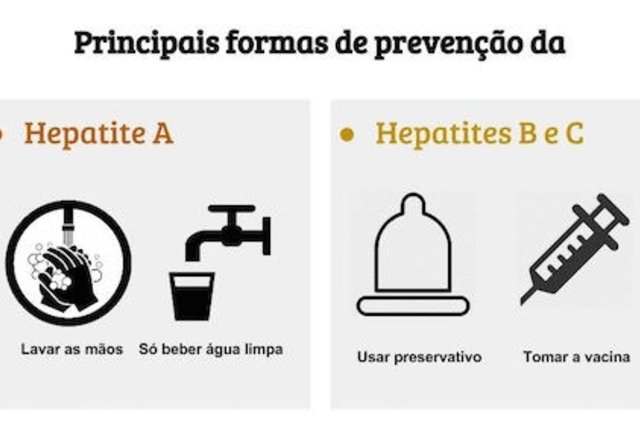The ways in which hepatitis is transmitted vary according to the related virus, and can occur through sexual intercourse without a condom, contact with blood, some secretions or contaminated sharp objects, and even through the consumption of contaminated water or food, which This is what happens in hepatitis A.
To avoid all types of hepatitis, it is important to adopt prevention measures, such as vaccines, which are available for hepatitis A and B, use of condoms during sexual intercourse, avoid reusing single-use materials, such as needles, and avoid consuming raw food and water. untreated. This way it is possible to avoid the development of hepatitis, which is a disease characterized by inflammation in the liver that increases a person’s risk of developing liver cancer and cirrhosis, for example.

How to prevent hepatitis A
Transmission of hepatitis A occurs through the consumption of water and food contaminated by the hepatitis A virus, HAV. Contamination also occurs when there is a lack of basic sanitation, allowing feces from infected people to reach rivers, springs or even plantations, which is why it is common for many people to be infected with hepatitis A in the same location.
Therefore, to prevent hepatitis A, it is important to pay attention to the modes of transmission, and it is recommended:
- Get the vaccine against hepatitis A, in accordance with the recommendations of the Ministry of Health;
- Have good hygiene habits washing your hands thoroughly before eating and after using the bathroom. See how to wash your hands well.
- Avoid raw foods and disinfect food well before eating, leaving food to soak in chlorinated water for 10 minutes;
- Prefer cooked foods or grilled because this way viruses are eliminated;
- Drink only potable water: mineral, filtered or boiled and take the same care when making juices, and avoid consuming water, juice, popsicles, bags, ice cream and salads that may have been prepared under poor hygiene conditions.
The people most at risk of contracting the hepatitis A virus are people with hepatitis C, residents of regions with poor basic sanitation and children, and when they are infected, they increase the risk of infecting their parents, siblings and teachers.
How to prevent hepatitis B and C
The hepatitis B virus, HBV, and hepatitis C virus, HCV, can be transmitted from person to person through contact with the blood or secretions of people who are infected with one of these viruses. To prevent these types of hepatitis, it is important to adopt some measures, such as:
- Get the vaccine hepatitis B, although there is still no vaccine against hepatitis C;
- Use condom in all intimate contact;
- Require disposable material new every time you get piercings, tattoos and acupuncture;
- Don’t use drugs injectables or use sterilized material;
- Do not share personal items with manicure kit and razor blade;
- Always use disposable gloves if you are going to help or treat someone’s wounds.
Hepatitis B and C can also be transmitted by healthcare professionals such as doctors, nurses or dentists, when they are infected and do not follow all safety standards such as wearing gloves whenever they come into contact with blood, secretions or using instruments that they can cut the skin, for example.
Why you should avoid hepatitis
Hepatitis is an inflammation of the liver, which does not always present symptoms and therefore the person can be infected and pass the disease on to others. Therefore, it is recommended that everyone follows these safety rules throughout their lives to avoid being infected and transmitting hepatitis to others.
Hepatitis is an inflammation of the liver that, even with adequate treatment, is not always curable, and this increases the risk of liver complications such as cirrhosis, ascites and liver cancer, for example. Learn more about hepatitis.

Sign up for our newsletter and stay up to date with exclusive news
that can transform your routine!
Warning: Undefined array key "title" in /home/storelat/public_html/wp-content/plugins/link-whisper-premium/templates/frontend/related-posts.php on line 12
Warning: Undefined array key "title_tag" in /home/storelat/public_html/wp-content/plugins/link-whisper-premium/templates/frontend/related-posts.php on line 13




